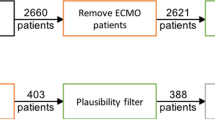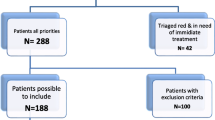Abstract
Objective
Therapeutic decisions in the Operating Room (OR) are often made based solely upon results obtained from arterial blood gas machines. We evaluated how precise and accurate the results obtained from Bayer Rapid Point 405 (RP405) were vis-à-vis those of our blood gas laboratory and if they met the standards of the members of the anesthesia department.
Methods
About 3 ml of blood from an indwelling arterial catheter were drawn into a heparinized syringe (FIMS Portex Inc.) from each of 90 patients and immediately analyzed by two RP405 and the hospital’s main blood gas machines (Instrumentation Laboratories GEM 3000). The remaining 2.8 ml of blood was used to measure Hematocrit and sent to the hospital’s main biochemistry laboratory for electrolyte measurement using an indirect ion selective method (Roche Diagnostics Modular ISE Module). A survey was distributed to each of the 19 anesthesiologists at the Sir Mortimer B Davis Jewish General Hospital (JGH). Their opinions for accuracy and treatment thresholds for each of the␣12 variables measured by the RP405 were sought.
Results
For all measured variables, including pH, pCO2, pO2, potassium and Hematocrit, the correlation between the measurements from the RP405 and the gold standard were all above 95.5% with a p < 0.001. The survey results demonstrate that the machine gives results that are accurate within the acceptability frame expected by our staff anesthesiologists.
Conclusion
Anesthesiologists must be confident that the information they receive is accurate in the context of rapidly changing clinical status. Our results show that the RP405 analyzers produce reliable measurements.
Similar content being viewed by others
References
Walton HG, Boucher DM, Marroquin R (2003) Comparison of blood gas and electrolyte test results from the Gem-Premier and the ABL-70 versus a conventional laboratory analyzer. J Extra Corp Technol 35:24–27
Schneider J, Dudziak R, Westphal K, Vetterman J (1997) The i-STAT analyzer. A new, hand-held device for the bedside determination of Hematocrit, blood gases, and electrolytes. Anaesthetist 46:704–714
Beneteau-Burnat B, Bocque MC, Lorin A (2004) Evaluation of the blood gas analyzer Gem PREMIER 3000. Clin Chem Lab Med 42:96–101
Wahr JA, Lau W, Tremper KK, Hallock L, Smith K (1996) Acccuracy and precision of a new, portable, handheld blood gas analyzer, the IRMA. J Clin Monit 12:317–324
Magny E, Renard M-F, Launay J-M (2001) Evaluation de l’analyseur de gazometrie sanguine RapidPoint 400. Ann Biol Clin 59: 622–628
Bland JM, Altman DG (1986) Statistical methods for assessing agreement between two methods of clinical measurement. Lancet 1: 307–310
Bland JM, Altman DG (1995) Comparing methods of measurement: why plotting difference against standard methos is misleading. Lancet 10: 1085–1087
Passing H, Bablok W (1983) A new biometrical procedure for testing the equality of measurements from two different analytical methods. Application of linear regression procedures for method comparison studies in Clinical Chemistry, Part I. J Clin Chem Clin Biochem 21:709–720
Combleet PJ, Gochman N (1979) Incorrect least-squares regression coefficients in method-comparison analysis. Clin Chem 25: 432–438
Hill AG, Enzer S, Marino JA et al. (1987) Clinical experience with a new portable blood gas and electrolyte analyzer during cardiopulmonary bypass. Proc Am Acad Cardiovasc Perfusion 8: 45–51
Author information
Authors and Affiliations
Corresponding author
Additional information
Sarrazin F, Tessler MJ, Kardash K, McNamara E, Holcroft C. Blood gas measurements using the Bayer Rapid Point 405: are we basing our decisions on accurate data?
Rights and permissions
About this article
Cite this article
Sarrazin, F., Tessler, M.J., Kardash, K. et al. Blood gas measurements using the Bayer Rapid Point 405: are we basing our decisions on accurate data?. J Clin Monit Comput 21, 253–256 (2007). https://doi.org/10.1007/s10877-007-9082-z
Received:
Accepted:
Published:
Issue Date:
DOI: https://doi.org/10.1007/s10877-007-9082-z




